Optimization of dietary phosphorus for broiler breeders and their progeny
Introduction
Sustainability of the poultry industry in the US, and especially in North Carolina, is somewhat dependent upon development of strategies to minimize environmental impact. The poultry industry has been largely able to comply with nitrogen-based land application rules for poultry litter but new rules based upon litter phosphorus content pose a much greater challenge. Preliminary estimates by university scientists in North Carolina suggest that up to four times more land will be needed for these phosphorus-based rules, and that land presently being used for litter application already possesses high levels of phosphorus. This scenario creates a sense of urgency for efforts intended to minimize fecal phosphorus in all areas of poultry production.
With broiler production over 9 billion birds per year in the US this industry segment, which includes broilers and broiler breeders (parent stock), is an obvious area of concern in terms of environmental impact. Broiler breeders produce the fertile hatching eggs that are used to produce broiler chicks. There are currently more than 50 million broiler breeders within the US. Broiler breeders each consume approximately 125 lbs of feed during a life cycle that lasts 65 weeks. Thus, as an example of the potential environmental impact, over 9 million broiler breeders in North Carolina consume more than 450,000 tons of feed annually. This equates to an addition of over 1.2 million lbs of pure inorganic phosphorus annually to the breeder layer feed alone.
Based upon information obtained from AgriStats® the average available phosphorous level in the US breeding diet is 0.37% with a high of 0.43% and low of 0.27%. Presumably, the lower level was facilitated by phytase addition. There is reason to believe that dietary total phosphorous levels of 0.40% are near the minimum without use of supplemental phytase (Wilson et al., 1980) and that available phosphorus levels of 0.10% may be reached in practical diets with phytase use (Berry et al., 2000). These data suggest that there is much potential to reduce fecal phosphorus excretion in these particular birds. However, the potential impact on broiler chickens hatched from eggs laid by breeder hens on low phosphorus diets has not been systematically investigated. The production of quality broiler progeny is the primary purpose of broiler breeders in North Carolina. Imposition of phosphorous reduction rules for broiler breeders without consideration of potential impact on broiler progeny performance could result in significant economic losses as well as significant negative impacts on animal welfare.
Background
Although there has been much written about phytase in recent years, a review of the research literature found few references specifically related to broiler breeders and their progeny. The most disturbing was a review by van Tuijl (1998) that recounted the results of phosphorus regulations in the Netherlands. In the case of broiler breeders, the initial results were increased mortality and morbidity that resulted in restoration of former dietary phosphorus levels in many cases. Most of the problems were due to insufficient phosphorus in both the grower and breeder diets that led to femoral head necrosis, leg weakness and associated bacterial infections.
Malabsorption syndrome was also observed. However, impacts of low dietary phosphorus in broiler breeders on the progeny were not studied in this retrospective survey of field results so the full implications are not known in these cases. It was concluded by van Tuijl (1998) that no conclusive recommendations could be made as to the minimum safe dietary phosphorus level for broiler breeders. This is a very important statement as the Netherlands has been very proactive in regulation of fecal phosphorus excretion.
Nevertheless there are some data from which estimates can be made about phosphorus requirement for broiler breeders. Wilson et al. (1980) reported that a total phosphorus level of 0.41% produced optimum hatchability and egg production from females during a 28-week production period. Total phosphorus levels of 0.36% and 0.31% gave slightly lower performance. Broiler breeder males were found to function acceptably from 32 to 48 weeks of age in cages with a total phosphorus intake of 300 mg/day (Bootwalla and Harms, 1989). Older birds are also reported to produce additional intestinal phytase (Edwards, 1993) and low dietary inorganic phosphorus serves to induce intestinal phytase (Moore and Veum, 1983). These latter effects may serve to facilitate lowered dietary phosphorus in adult broiler breeders when typical diets are fed. It should also be noted that most broiler breeder diets contain wheat byproducts that are thought to contain significant levels of phytase that would be active in typical mash type diets. A recent report by Berry et al. (2000) suggests that an available phosphorus level of 0.1% can be reached with the use of supplemental phytase. Although this study encompassed a full production cycle, the effects on progeny were not studied. Further, calculations from the NRC (1994) suggested requirement of 350 mg inorganic phosphorus per day translates to a dietary level of 0.21-0.24% available phosphorus, depending upon feed intake.
Triyuwanta et al. (1992) studied the progeny from dwarf broiler breeder hens fed 2, 6, or 10 g available phosphorus per kg diet (0.2, 0.6, or 1.0%). They found tibial breaking strength of the progeny to improve markedly with increasing maternal dietary phosphorus, but this effect was not evident at seven weeks of age after receiving normal broiler diets during the grow out. This means that the leg quality at hatch of chicks from breeders fed low phosphorus diets was compromised and then restored by adequate phosphorus in the broiler diets. The effect on progeny of even lower phosphorus levels is unknown, especially in combination with low phosphorus broiler diets.
General experimental procedures
This study consisted of two experimental series each comprised of one broiler breeder flock and two broiler flocks. In designing the experiments we wished to feed and manage the broiler breeders in a way that would be similar to what would be done under commercial conditions and to avoid some of the problems that other researchers have encountered. To this end we fed mash diets, as a high percentage of US broiler breeder diets are in such form. Further, it is common to have a wheat by-product such as wheat midds or wheat bran in the formula as filler. As data from our laboratory has indicated that the frame of the broiler breeder is largely built by eight weeks of age, we wanted to feed a normal diet to that age and then begin to reduce the phosphorus a little to encourage metabolic efficiency before removing all the phosphorus from some diets when the birds were moved from the growing to laying quarters at 21 weeks of age. Finally, as chickens on low phosphorus diets show sensitivity to heat stress we wanted the birds to lay during summer in houses that were not evaporatively cooled.
Procedures: Experimental Series 1
Broiler breeder pullets and cockerels (Arbor Acres Yield males and FSY females) were reared on standard diets and feeding regimens that included 0.90% calcium and 0.45% available phosphorus (to eight weeks of age) and cumulative nutrient intakes of metabolizable energy and protein to 20 weeks of age that are known to be sufficient to ensure acceptable egg production and fertility. At eight weeks of age the dietary available phosphorus was reduced in the pullet diets to 0.35-0.40% with 0.80% calcium. The cockerels remained on the normal diets throughout rearing to ensure good leg quality, which is essential for males that are actively breeding. The breeders were reared in blackout houses with 8 hrs of light daily on our standard feeding program that produces body weights slightly above the primary breeder guidelines.
Broiler breeders, males and females in Breeder Experiment 1 received the test diets (Table 1) from housing in the laying quarters at 21 weeks of age to end of the experiment. The phosphorus levels were chosen on the basis that Treatments 1 and 2 represent the highest level used in the US industry (0.40%). In order to work within the realm of commercial practice that is possible with available feed ingredients, Treatments 7 and 8 (0.10%) were the lowest phosphorus levels possible as a result of removing all supplemental dicalcium phosphate and amending the diets with limestone to replace the lost calcium and builder’s sand to replace the remaining lost volume and density. Treatments 3 and 4 and Treatments 5 and 6 were scaled between the extreme treatments to provide a dosimetry. In order to ensure adequate phytase, a minimum level of 500 PU/kg from AllzymeTM SSF phytase was used in this study. The objective was not to test the efficacy of phytase (a proven commodity), but to determine the lower safety limit of dietary phosphorus in broiler breeder diets and the carryover effect in the progeny. A slightly elevated phytase level ensured no deficiency due to enzyme stability or mixing problems. The diets contained 2.75% calcium as used by Berry et al. (2000), which is standard in this laboratory.
Table 1. Dietary treatments in Breeder Experiment 1.
1 Calculated available P levels are estimates based upon a terminal dilution method of diet preparation. The diet with the lowest available P contained no added inorganic P.
2 Added phytase (AllzymeTM SSF, Alltech Inc.) at least 500 PU/kg of diet.
During the laying period the birds were housed in an industry standard two-thirds slat, one-third litter facility where most of the feces fell beneath the slats and were not available for coprophagy. There were 16 pens of approximately 50 females and 6 males each. Thus, the experimental design was a 4 x 2 factorial with four phosphorus levels and two phytase levels with two pens per interaction cell.
The breeders came into egg production in hot weather in an open-sided house. Broiler breeders in this house do not normally exhibit excessive mortality due to heat stress but will permit such to become evident if the conditions are correct. Egg production, feed consumption, and mortality were determined on a daily basis. Eggs were set biweekly for determination of fertility and fertile hatchability using standard proven research methodology. Fecal total phosphorus was determined in each of the eight treatments at the end of the breeding period prior to land application as would be the typical cleanout practice for broiler breeders. The experiment was conducted from October 2000 to January 2002 and 25 weeks of production data are summarized in this report.
At two ages (32 and 61 weeks of age) all eggs laid on two consecutive days were incubated together and male chicks were placed in a 32-pen litter floor broiler house for growout evaluation to seven weeks of age. The 32-pen house provided four replicate pens per each of the eight breeder treatments. Males were used as they are the sex with the most leg problems typically and should be the most sensitive to mineral imbalances. Thus, the final design for the broiler males was a 4 x 2 factorial with four breeder phosphorus levels and two breeder phytase levels. A review of AgriStats® data showed that on average, US broiler feed available phosphorus level was 0.38% with a high of 0.47% and a low of 0.28%, again the latter presumably with phytase addition. The broiler calculated dietary available phosphorus level chosen for Broiler Experiments 1 and 2 was 0.25% with the inclusion of a minimum of 500 PU/kg phytase to mimic broiler feed formulations in low phosphorus feed environments. Broilers were evaluated on the basis of body weight, feed efficiency, and mortality. Diets were fed in mash form.
Results: Experimental Series 1
Even though the breeders were fed quite minimal levels of feed there were no effects whatsoever of dietary phosphorus or phytase. This was probably due to the fact that the summer conditions were not very hot and that the diets for Breeder Experiment 1 contained less than 1% wheat bran but that this ingredient, along with small contributions from corn and soybean meal, contained sufficient phytase activity to meet the needs of the breeders. Nevertheless, these data suggested that there would be no great damage to the breeders of using no added phosphorus during the breeding period if the breeders had been grown in such a manner as to optimize skeletal development and metabolic efficiency. As shown in Tables 2 and 3 there were no effects on the broilers in either Broiler Experiment 1 or 2.
Experimental procedures: Experimental Series 2
In order to deal with the experimental design issues raised by the results of Experimental Series 1 we grew another broiler breeder flock in a similar manner except that we removed the wheat bran from the breeder diet and, by chance, encountered very hot summer weather. To improve the statistical sensitivity of the experiments we reduced the breeder diet series to just the highest and lowest available phosphorus levels used in Breeder Experiment 1. Broiler breeders (Ross 344 males and Ross 308 females) in Breeder Experiment 2 were reared exactly as indicated for Breeder Experiment 1 but received the diets in Table 4 from housing in the laying quarters at 21 weeks of age to end of the experiment. Management of the broiler breeders was similar to that described for the broiler breeders in Breeder Experiment 1 with the exception of details outlined below. The experiment was conducted from September 2001 to September 2002 and 26 weeks of production data are summarized in this report.
Table 2. Effect of dietary available phosphorus and AllzymeTM SSF phytase in broiler breeder diets on male broiler progeny performance to 49 days of age in Broiler Experiment 1. 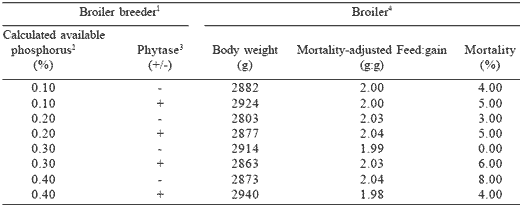
1 Breeders were 32 weeks of age.
2 Breeder diets created by terminal dilution method. No added dicalcium phosphate in lowest diet.
3 Minimum of 500 PU/kg phytase (AllzymeTM SSF, Alltech Inc).
4 Broiler diets formulated for a calculated available P level of 0.25% with a minimum of 500 PU phytase/kg.
Table 3. Effect of dietary available phosphorus and AllzymeTM SSF phytase in broiler breeder diets on male broiler progeny performance to 49 days of age in Broiler Experiment 2.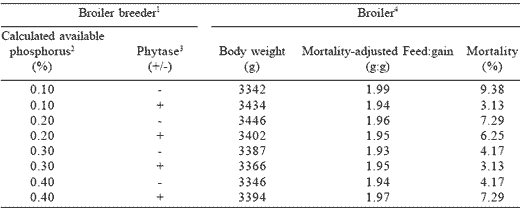
1 Breeders were 61 weeks of age.
2 Breeder diets created by terminal dilution method. No added dicalcium phosphate in lowest diet.
3 Minimum of 500 PU/kg phytase (AllzymeTM SSF, Alltech Inc).
4 Broiler diets formulated for a calculated available P level of 0.25% with a minimum of 500 PU phytase/kg.
Table 4. Dietary treatments in Breeder Experiment 2.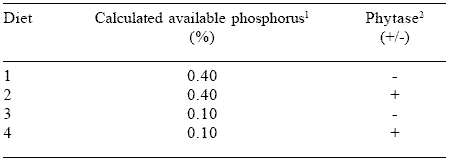
1 Calculated available P levels are estimates based upon a terminal dilution method of diet preparation.
2 Added phytase (AllzymeTM SSF), at least 500 PU/kg of diet.
The breeders in Breeder Experiment 2 came into egg production in hot weather in a fan-ventilated closed-sided house that had no evaporative cooling capabilities. This particular summer (2002) produced some of the highest temperatures in history and heat stress was evident. Unfortunately, the house burned when the flock was 50 weeks of age and all of the data were truncated. Fortunately, two broiler progeny flocks had been hatched before this accident occurred.
At two ages (35 and 43 weeks of age) all eggs laid on two consecutive days were incubated together and male chicks were placed in a 64-pen litter floor broiler house for growout evaluation to six weeks of age. The broiler experimental period was reduced by one week compared to the previous series because of the unusually hot weather. The 64-pen house provided 16 replicate pens per each of the four breeder treatments that were further divided to more fully evaluate the effects of broiler dietary phosphorus and possible interactions with the breeder diets. Two levels of calculated dietary available phosphorus were used in the broiler diets in Broiler Experiment 3. These were 0.25% and 0.18% with the inclusion of a minimum of 500 PU phytase/kg. Four levels of calculated dietary available phosphorus were used in the broiler diets in Broiler Experiment 4. These were 0.25, 0.21, 0.16 and 0.12% with the inclusion of a minimum of 500 PU phytase/kg.
Results: Experimental Series 2
In the case of the broiler breeders there was significantly higher female mortality during the hottest part of the summer for the treatment group (Diet 3 in Table 4) with the lowest dietary phosphorus without phytase. The males were not similarly affected. This high female mortality resulted in fewer eggs laid per hen housed but no effect on hen-day egg production, fertility or hatchability of fertile eggs (Table 5). Egg weight and egg shell quality were also unaffected. The data suggest that if the broiler breeder hens did not die they performed normally and were not affected by the severe heat stress and phosphorus deficiency.
Table 6 shows the interaction means for body weight, feed efficiency and mortality to 42 days of age in Broiler Experiment 3. On an overall basis the breeder phosphorus level had no effect on broiler performance. Breeder phytase had no effect on broiler mortality and feed efficiency, but 42-day body weight showed a slight reduction (2167 versus 2114 grams; P<0.07). As expected, broiler body weight was decreased by the lower phosphorus level (2302 versus 1980 g; P<0.001) and mortality was increased (2.67 versus 9.60%; P<0.01) while mortality adjusted feed efficiency was unaffected.
The interaction means for body weight, feed efficiency and mortality for Broiler Experiment 4 are shown in Table 7. On an overall basis breeder phosphorus level again had no effect on broiler performance. Breeder phytase had no effect on broiler mortality and feed efficiency but 42-day body weight again showed a slight reduction (2210 versus 2149 g; P<0.05).
Table5. Effect of dietary available phosphorus and phytase in broiler breeder diets on breeder performance to 50 weeks of age in Breeder Experiment 2.
A,B Means with different superscripts differ significantly (P<0.01).
1 Breeder diets created by removing added dicalcium phosphate in lowest diet.
2 Minimum of 500 PU phytase/kg (AllzymeTM SSF).
Again, as expected, broiler body weight was decreased by the lower phosphorus levels (2444, 2297, 2113 and 1864 g, respectively, for the 0.25, 0.21, 0.16, and 0.12% broiler available phosphorus levels; P<0.001) and mortality was increased (2.46, 1.79, 6.25, 16.52%, respectively, for the 0.25, 0.21, 0.16, and 0.12% broiler available phosphorus levels; P<0.001) while mortality adjusted feed efficiency was unaffected.
General discussion and conclusions
The broiler breeder data suggest that these birds can lay perfectly well with no added inorganic phosphorus in the breeder laying diet as long as there is added phytase during hot weather. In the case of the Breeder Experiment 2 there was high mortality in the absence of both added inorganic phosphorus and phytase but the hens that did not die performed perfectly well in terms of egg production, fertility, and hatchability. This suggests that there is a population of broiler breeders that do not have sufficient intestinal phytase to obtain their daily phosphorus requirements from a corn-soy diet. This population can be estimated to be about 40% of the flock under the conditions of this particular experiment. Thus, the breeder data indicate that with an appropriate global management strategy we can significantly reduce the intake of inorganic phosphorus in these birds without significant negative impact on their performance.
Table 6. Effect of dietary available phosphorus and AllzymeTM SSF phytase in broiler breeder diets and dietary available phosphorus in broiler diets on male broiler progeny performance to 42 days of age in Broiler Experiment 3. 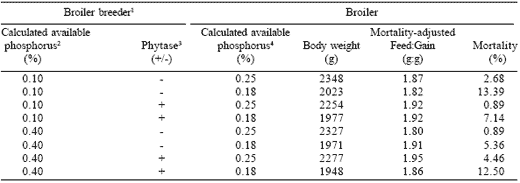
1 Breeders were 35 weeks of age.
2 Breeder diets created by removing added dicalcium phosphate in lowest diet.
3 Minimum of 500 PU phytase/kg (AllzymeTM SSF, Alltech Inc).
4 Broiler diets formulated for calculated available P levels shown with a minimum of 500 PU phytase/kg.
Table 7.Effect of dietary available phosphorus and AllzymeTM SSF phytase in broiler breeder diets and dietary available phosphorus in broiler diets on male broiler progeny performance to 42 days of age in Broiler Experiment 4. 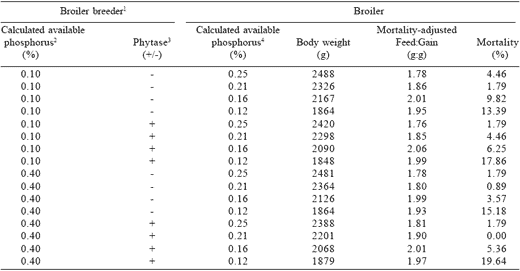
1 Breeders were 43 weeks of age.
2 Breeder diets created by removing added dicalcium phosphate in lowest diet.
3 Minimum of 500 PU phytase/kg (AllzymeTM SSF, Alltech Inc).
4 Broiler diets formulated for calculated available P levels shown with a minimum of 500 PU phytase/kg.
With regard to the broiler data, when we found no effects on the breeders there were no effects in the broilers (Experimental Series 1). When we saw effects in the breeders we found effects in the broilers (Experimental Series 2). While there was no effect of breeder phosphorus level on broiler performance we did find a decrease in broiler body weight as the result of phytase inclusion in the breeder diet in both Broiler Experiments 3 and 4. This effect was independent of either breeder or broiler dietary phosphorus levels (i.e. no statistical interactions). The fact that the broilers were performing normally is attested to by the perfect dose response to dietary phosphorus evidenced in Broiler Experiments 3 and 4. Thus, there is some ‘vertical’ effect from parent to progeny demonstrated here that although small, is real as evidenced by the fact that the effect repeated nicely. There have been comments from European authors that phytase cannot be used in both breeders and broilers. This body weight effect may be the reason for this comment but there is no reason that this cannot be dealt with. It seems to the present authors that the probable cause for this effect is some alteration of metabolic function in the broilers that has been caused by the use of phytase in the breeder hen under the conditions of this study. The effect simply has to be found and dealt with, as there is no option to reducing fecal phosphorus excretion in North Carolina.
In examining the broiler response to dietary available phosphorus, the results were as expected with the broilers demonstrating reduced performance as phosphorus was reduced without an increase in phytase (endogenous or exogenous). The fact that the difference in body weight due to breeder phytase did not appear until 35 days of age suggests that endogenous phytase is not being induced to the same degree. Most of the broiler mortality was either skeletal in nature or due to ascites. We have not yet examined bone quality as in reality leg quality need only be sufficient to allow birds to feed and drink. A larger problem may be the incidence of broken wing tips or other bone breakage during picking and processing. This was examined by observing the broilers during slaughter, picking, and processing in a commercial facility. We saw no bone quality problems during processing, in fact these birds performed better than others of the company involved.
References
Berry, W.D., J.X. Zhang, P. Liu, D.A. Roland and G.R. McDaniel. 2000. Effect of supplemental dietary phytase on egg production, fertility and hatchability of broiler breeder hens. Poultry Sci. 79(Suppl. 1):62 (Abstr.).
Bootwalla, S.M. and R.H. Harms. 1989. Research Note: Effect of supplemental dietary phosphorus on the reproductive capacity and bone integrity of broiler breeder males fed a corn-soybean diet. Poultry Sci. 68:1153-1155.
Edwards, H.M., Jr. 1993. Dietary 1, 25-dihydroxycholecalciferol supplementation increases natural phytate phosphorus utilization in chickens. J. Nutr. 123:567-577.
Moore, R.J. and T.L. Veum. 1983. Adaptive increase in phytate digestibility by phosphorusdeprived rats and the relationship of intestinal phytase and alkaline phosphatase to phytate utilization. Br. J. Nutr. 49:145-152.
National Research Council. 1994. Nutrient Requirements of Poultry. National Academy Press, Washington, D.C.
Triyuwanta, C.L. and Y. Nys. 1992. Dietary phosphorus and food allowance of dwarf breeders affect reproductive performance of hens and bone development of their progeny. Brit. Poult. Sci. 33:363-379.
van Tuijl, O.A. 1998. Field observations and practical implications resulting from reductions in the phosphorus content of breeder and broiler diets. World’s Poult. Sci. J. 54:359-363.
Wilson, H.R., E.R. Miller, R.H. Harms and B.L. Damron. 1980. Hatchability of chicken eggs as affected by dietary phosphorus and calcium. Poultry Sci. 59:1284-1289.
Authors: J. BRAKE, C.V. WILLIAMS AND B.A. LENFESTEY
Department of Poultry Science, North Carolina State University, Raleigh, NC, USA








.jpg&w=3840&q=75)